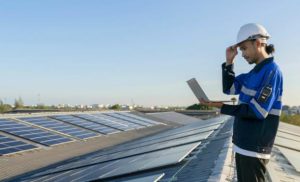What Are the Latest Advances in Solar Panels?
Introduction: Pushing the Boundaries of Solar Technology
The field of solar energy continues to witness remarkable advancements, with recent breakthroughs revolutionizing the efficiency, affordability, and sustainability of solar panels. From novel materials to innovative designs, the latest advances in solar panels are shaping the future of renewable energy production.

Perovskite Solar Cells: Pioneering Efficiency
Perovskite solar cells have emerged as a game-changer in the quest for higher efficiency and lower production costs. These next-generation solar cells, featuring a perovskite-structured compound as the light-harvesting layer, have achieved stunning efficiency records. In laboratory settings, perovskite solar cells have surpassed 25% efficiency, rivaling traditional silicon-based cells. Moreover, their compatibility with low-cost manufacturing processes holds promise for scalable and affordable solar energy solutions.
Bifacial Technology: Capturing More Sunlight
Bifacial solar panels represent another significant advancement in solar panel design. Unlike conventional monofacial panels, bifacial panels can harvest sunlight from both the front and rear surfaces, effectively doubling their energy generation potential. Recent innovations in bifacial technology have pushed efficiency gains to 20% or more, particularly in environments with high reflectivity. This versatility makes bifacial panels ideal for a wide range of applications, from utility-scale solar farms to commercial rooftops.
Flexible and Transparent Solar Panels: Versatile Integration
The development of flexible and transparent solar panels is opening up new possibilities for solar integration in unconventional settings. These lightweight and bendable panels can conform to curved surfaces, enabling seamless integration into buildings, vehicles, and consumer electronics. Additionally, transparent solar panels allow for dual functionality, serving as both windows and energy generators. With efficiency levels reaching 15% and beyond, flexible and transparent solar panels are reshaping the urban landscape and redefining the concept of building-integrated photovoltaics.
Enhanced Durability and Longevity
Advancements in materials science and manufacturing processes have led to improvements in the durability and longevity of solar panels. Enhanced encapsulation materials, such as advanced polymers and glass coatings, provide better protection against moisture, UV radiation, and mechanical stress. Moreover, rigorous testing standards and quality control measures ensure that solar panels maintain optimal performance over their operational lifespan, contributing to their reliability and resilience in harsh environmental conditions.
Conclusion
In conclusion, the latest advances in solar panels encompass a wide range of technologies and innovations, from perovskite solar cells and bifacial technology to flexible and transparent panels. These advancements not only push the boundaries of efficiency and performance but also drive down costs and expand the possibilities for solar integration across various sectors. To stay updated on the latest developments in solar panel technology, visit solar panels advances.